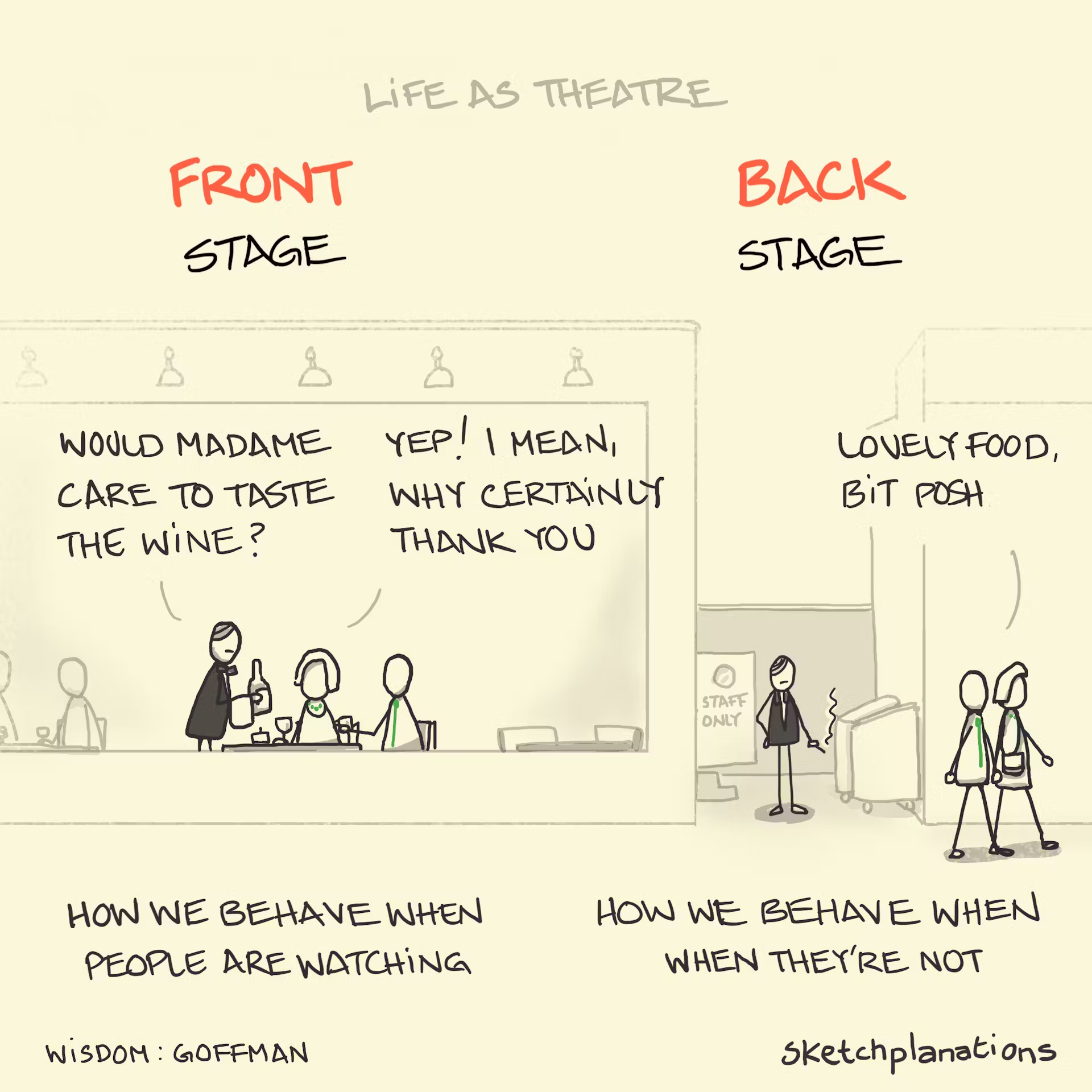Throughout my upbringing, my Mother consistently cautioned me about the potential risks of using social media platforms. Notoriously, she’d say, “You can be anyone you want to be on social media, which is why you should always be careful of who you interact with, as you never truly know someone through the lens of social media”. Of course, I didn’t understand the magnitude of what her words meant until I disconnected from social media altogether.
Evring Goffman, a renowned sociologist, focuses on the concepts of interaction and how we present ourselves as individuals, looking at these versions of ourselves in a theatrical-like manner. Our interactions with one another are seen as the “performance” tailored by those around us and our environments. Our social identities are described as the “front”. Furthermore, our front is designed to appease those around us, rendering a tailored positive experience one may have of us upon each interaction. With the evolution of interaction comes the evolution of the stages at which we perform. Although Goffman’s theories came around before the evolution of social interaction and communication, we can still see how his concepts remain relevant today.

The ideology of “impression management”, another work of Erving Goffman, explains how we, as humans, attempt to control the impression others have of us. We must be perceived in the fashion that we’ve tailored ourselves to be displayed as. Form-fitting like a well-constructed suit, the way we “wear” ourselves is imperative to our social presence and the way we’re consumed by our audiences. Having access to social media allows us to construct ourselves in ways we feel can be best consumed by our digital audiences. When we create our social profiles, we’re creating faces that can be seen by a plethora of individuals (our audiences). Each platform offers a new face that we’re able to tailor to our liking. The way we may present ourselves on Facebook to our families may not be the same way we’d present ourselves to our close friends on Instagram. Although we tailor these faces to our ideal conception, we arguably eliminate the opportunity for someone to get to see ourselves beyond our faces.
As a former social media user, I can comprehend just how easy it is to fabricate ourselves and create a version of ourselves that we feel most inclined to present to others. The concept of “being yourself” seems to me like a paradox, as we live our lives through an identity that we’ve created to be the most suitable version of ourselves for an alternative reality that doesn’t truly exist within reality itself. Who are we really? Will we truly ever know who we are as individuals? We don’t have the luxury of experiencing ourselves from an outside perspective as if we were another individual– we can only experience ourselves from a first-person perspective, internally as opposed to externally. Even today, as someone who’s lived on this planet for 20 years, I feel like I know very little about myself and who I really am. I believe there are many faces of Amaya, some of which have yet to be discovered.
I do feel like constantly having to perform a version of ourselves seems pretty mentally exhausting; it feels as if you’re never truly living life in its authenticity, but rather experiencing life through its fabrication. Where’s the harm in being honest? Behaving and responding in ways that feel most natural to you, and not rehearsed for the sake of social appeasement? I do find it quite ironic when we make a spectacle of someone who causes a public scene or exhibits behaviors that seem foreign or alienated from social norms. Realistically, those individuals may be exhibiting behaviors that align more closely with personal authenticity than we think. Learning about Erving Goffman makes me wonder why we care so much about the way we’re perceived. I really want to learn about why we live our lives living for the audience of others.
Goffman, Erving. The Presentation of Self in Everyday Life. Doubleday: Garden City, New York, 1959.
(Source: Goffman, Erving (1990) The Presentation of Self in Everyday Life, Harmondsworth: Penguin, pp. 111-21)


I really enjoyed reading your blog. The introduction using your mother’s warning about social media was a simple but powerful way to start, and it felt relatable and easy to understand. You clearly explained Goffman’s theory, showing how we all have a “front stage” and present different versions of ourselves to different audiences. The metaphor of the well-fitted suit was also very effective in describing how we shape our social identities.
The questions you asked — “Who are we really? Will we ever know who we are?” — really resonated with me. I asked myself the same thing and realised that I also don’t truly know who I am. I especially liked your reflection about people who act “strangely” in public possibly being closer to their real selves. It’s ironic but very true, because most of us hide parts of ourselves just to fit in.
One thing I think could make the blog even stronger is adding more concrete examples. For example, you could discuss how people actually benefit from their “front stage” identities, like becoming more popular or even turning into influencers through a carefully built online image. That would make the blog more vivid and thought-provoking.